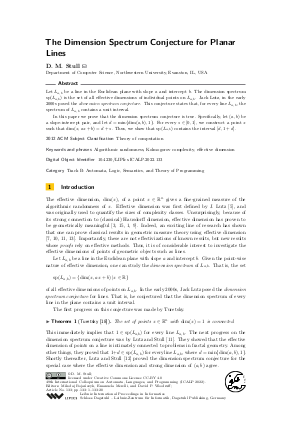The Dimension Spectrum Conjecture for Planar Lines
Author D. M. Stull
-
Part of:
Volume:
49th International Colloquium on Automata, Languages, and Programming (ICALP 2022)
Part of: Series: Leibniz International Proceedings in Informatics (LIPIcs)
Part of: Conference: International Colloquium on Automata, Languages, and Programming (ICALP) - License:
 Creative Commons Attribution 4.0 International license
Creative Commons Attribution 4.0 International license
- Publication Date: 2022-06-28
File

PDF
LIPIcs.ICALP.2022.133.pdf
- Filesize: 0.66 MB
- 20 pages
Document Identifiers
Subject Classification
ACM Subject Classification
- Theory of computation
Keywords
- Algorithmic randomness
- Kolmogorov complexity
- effective dimension
Metrics
- Access Statistics
-
Total Accesses (updated on a weekly basis)
0Document
0Metadata
Abstract
Let L_{a,b} be a line in the Euclidean plane with slope a and intercept b. The dimension spectrum sp(L_{a,b}) is the set of all effective dimensions of individual points on L_{a,b}. Jack Lutz, in the early 2000s posed the dimension spectrum conjecture. This conjecture states that, for every line L_{a,b}, the spectrum of L_{a,b} contains a unit interval.
In this paper we prove that the dimension spectrum conjecture is true. Specifically, let (a,b) be a slope-intercept pair, and let d = min{dim(a,b), 1}. For every s ∈ [0, 1], we construct a point x such that dim(x, ax + b) = d + s. Thus, we show that sp(L_{a,b}) contains the interval [d, 1+ d].
Cite As Get BibTex
D. M. Stull. The Dimension Spectrum Conjecture for Planar Lines. In 49th International Colloquium on Automata, Languages, and Programming (ICALP 2022). Leibniz International Proceedings in Informatics (LIPIcs), Volume 229, pp. 133:1-133:20, Schloss Dagstuhl – Leibniz-Zentrum für Informatik (2022)
https://doi.org/10.4230/LIPIcs.ICALP.2022.133
BibTex
@InProceedings{stull:LIPIcs.ICALP.2022.133,
author = {Stull, D. M.},
title = {{The Dimension Spectrum Conjecture for Planar Lines}},
booktitle = {49th International Colloquium on Automata, Languages, and Programming (ICALP 2022)},
pages = {133:1--133:20},
series = {Leibniz International Proceedings in Informatics (LIPIcs)},
ISBN = {978-3-95977-235-8},
ISSN = {1868-8969},
year = {2022},
volume = {229},
editor = {Boja\'{n}czyk, Miko{\l}aj and Merelli, Emanuela and Woodruff, David P.},
publisher = {Schloss Dagstuhl -- Leibniz-Zentrum f{\"u}r Informatik},
address = {Dagstuhl, Germany},
URL = {https://drops.dagstuhl.de/entities/document/10.4230/LIPIcs.ICALP.2022.133},
URN = {urn:nbn:de:0030-drops-164749},
doi = {10.4230/LIPIcs.ICALP.2022.133},
annote = {Keywords: Algorithmic randomness, Kolmogorov complexity, effective dimension}
}
Author Details
References
-
Randall Dougherty, Jack Lutz, R Daniel Mauldin, and Jason Teutsch. Translating the Cantor set by a random real. Transactions of the American Mathematical Society, 366(6):3027-3041, 2014.

-
Rod Downey and Denis Hirschfeldt. Algorithmic Randomness and Complexity. Springer-Verlag, 2010.

-
Xiaoyang Gu, Jack H Lutz, Elvira Mayordomo, and Philippe Moser. Dimension spectra of random subfractals of self-similar fractals. Annals of Pure and Applied Logic, 165(11):1707-1726, 2014.

-
Ming Li and Paul M.B. Vitányi. An Introduction to Kolmogorov Complexity and Its Applications. Springer, third edition, 2008.

-
Jack H. Lutz. Dimension in complexity classes. SIAM J. Comput., 32(5):1236-1259, 2003.

-
Jack H. Lutz. The dimensions of individual strings and sequences. Inf. Comput., 187(1):49-79, 2003.

- Jack H. Lutz and Neil Lutz. Algorithmic information, plane Kakeya sets, and conditional dimension. ACM Trans. Comput. Theory, 10(2):Art. 7, 22, 2018. URL: https://doi.org/10.1145/3201783.
-
Jack H Lutz and Neil Lutz. Who asked us? how the theory of computing answers questions about analysis. In Complexity and Approximation, pages 48-56. Springer, 2020.

-
Jack H. Lutz and Elvira Mayordomo. Dimensions of points in self-similar fractals. SIAM J. Comput., 38(3):1080-1112, 2008.

-
Neil Lutz. Fractal intersections and products via algorithmic dimension. In 42nd International Symposium on Mathematical Foundations of Computer Science (MFCS 2017), 2017.

-
Neil Lutz and D. M. Stull. Bounding the dimension of points on a line. In Theory and applications of models of computation, volume 10185 of Lecture Notes in Comput. Sci., pages 425-439. Springer, Cham, 2017.

-
Neil Lutz and D. M. Stull. Dimension spectra of lines. In Unveiling dynamics and complexity, volume 10307 of Lecture Notes in Comput. Sci., pages 304-314. Springer, Cham, 2017.

-
Neil Lutz and D. M. Stull. Projection theorems using effective dimension. In 43rd International Symposium on Mathematical Foundations of Computer Science (MFCS 2018), 2018.

-
Elvira Mayordomo. A Kolmogorov complexity characterization of constructive Hausdorff dimension. Inf. Process. Lett., 84(1):1-3, 2002.

-
Elvira Mayordomo. Effective fractal dimension in algorithmic information theory. In S. Barry Cooper, Benedikt Löwe, and Andrea Sorbi, editors, New Computational Paradigms: Changing Conceptions of What is Computable, pages 259-285. Springer New York, 2008.

-
Andre Nies. Computability and Randomness. Oxford University Press, Inc., New York, NY, USA, 2009.

-
D. M. Stull. Results on the dimension spectra of planar lines. In 43rd International Symposium on Mathematical Foundations of Computer Science, volume 117 of LIPIcs. Leibniz Int. Proc. Inform., pages Art. No. 79, 15. Schloss Dagstuhl. Leibniz-Zent. Inform., Wadern, 2018.

-
Daniel Turetsky. Connectedness properties of dimension level sets. Theor. Comput. Sci., 412(29):3598-3603, 2011.

